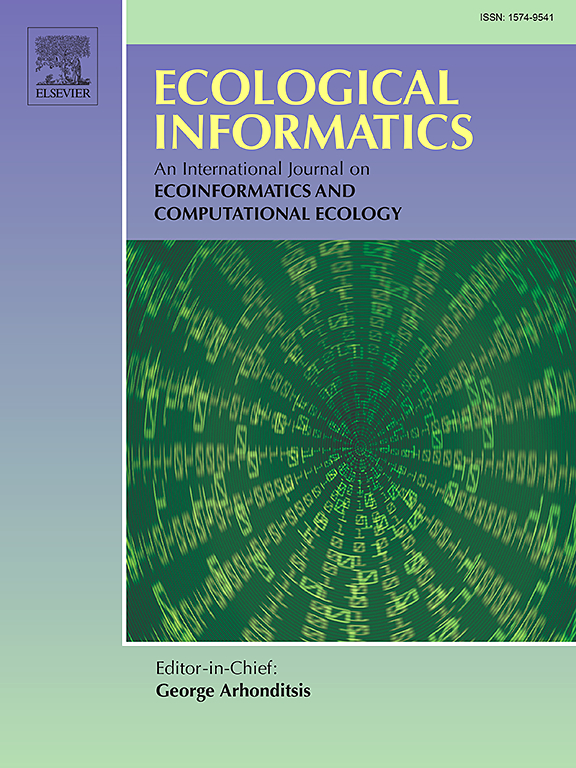Estimating vegetation aboveground biomass in Yellow River Delta coastal wetlands using Sentinel-1, Sentinel-2 and Landsat-8 imagery
IF 5.8
2区 环境科学与生态学
Q1 ECOLOGY
引用次数: 0
Abstract
Accurate analyzing the spatial pattern and spatial uncertainty of vegetation aboveground biomass (AGB) in coastal wetland is critical for addressing sustainable blue carbon management goals. Eight models based on Extreme Gradient Boosting (XGBoost) method were established to analyze the capability of Sentinel-1 (S1), Sentine-2 (S2) and Landsat-8 (L8) data for predicting AGB in coastal wetlands of the Yellow River Delta (YRD), China. Spatial uncertainty of AGB was quantified by Quantile Regression Forest (QRF) method. The results showed that AGB model based on S2 achieved higher model performance (R2: 0.74, RMSE: 171.23 g/m2) compared with those based on L8 (R2: 0.59, RMSE: 198.84 g/m2) and S1 (R2: 0.43, RMSE: 219.60 g/m2). The AGB model based on S1, S2, L8 and other predictive variables including the terrain and biophysical factors (S1S2L8plus) achieved the highest model performance (R2: 0.80, RMSE: 154.98 g/m2) among all the models. Red-edge related-spectral indices derived from S2 were proved to be important predictors in AGB modelling. The spatial uncertainty quantified by QRF showed the spatial prediction uncertainties of AGB models based on S2S2L8plus and S2 were lower than AGB model based on S1L8. The results of this study demonstrate the suitability of optical remote sensing data especially S2 and the weak capability of S1 in modelling AGB in coastal wetlands of the YRD. The regularly modelling, mapping and uncertainty estimations of AGB could help guide the sustainable blue carbon management in coastal wetlands.
基于Sentinel-1、Sentinel-2和Landsat-8影像的黄河三角洲滨海湿地地上植被生物量估算
准确分析滨海湿地植被地上生物量(AGB)的空间格局和空间不确定性对实现可持续蓝碳管理目标至关重要。基于极端梯度增强(XGBoost)方法建立了8个模型,分析了Sentinel-1 (S1)、sentinel -2 (S2)和Landsat-8 (L8)数据对黄河三角洲滨海湿地AGB的预测能力。采用分位回归森林(QRF)方法量化了AGB的空间不确定性。结果表明,与L8 (R2: 0.59, RMSE: 198.84 g/m2)和S1 (R2: 0.43, RMSE: 219.60 g/m2)相比,基于S2的AGB模型(R2: 0.74, RMSE: 171.23 g/m2)具有更高的模型性能。基于S1、S2、L8和地形、生物物理因子(S1S2L8plus)等预测变量的AGB模型在所有模型中模型性能最高(R2: 0.80, RMSE: 154.98 g/m2)。从S2得到的红边相关光谱指数被证明是AGB模型的重要预测因子。QRF量化的空间不确定性表明,基于S2S2L8plus和S2的AGB模型的空间预测不确定性低于基于S1L8的AGB模型。研究结果表明,光学遥感数据尤其是S2数据在长三角洲滨海湿地AGB模拟中的适用性,S1数据的模拟能力较弱。定期对AGB进行建模、制图和不确定性估算,有助于指导滨海湿地蓝碳的可持续管理。
本文章由计算机程序翻译,如有差异,请以英文原文为准。
求助全文
约1分钟内获得全文
求助全文
来源期刊

Ecological Informatics
环境科学-生态学
CiteScore
8.30
自引率
11.80%
发文量
346
审稿时长
46 days
期刊介绍:
The journal Ecological Informatics is devoted to the publication of high quality, peer-reviewed articles on all aspects of computational ecology, data science and biogeography. The scope of the journal takes into account the data-intensive nature of ecology, the growing capacity of information technology to access, harness and leverage complex data as well as the critical need for informing sustainable management in view of global environmental and climate change.
The nature of the journal is interdisciplinary at the crossover between ecology and informatics. It focuses on novel concepts and techniques for image- and genome-based monitoring and interpretation, sensor- and multimedia-based data acquisition, internet-based data archiving and sharing, data assimilation, modelling and prediction of ecological data.
 求助内容:
求助内容: 应助结果提醒方式:
应助结果提醒方式:


